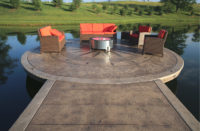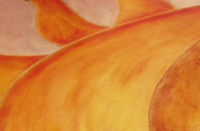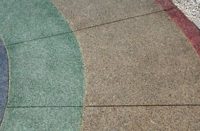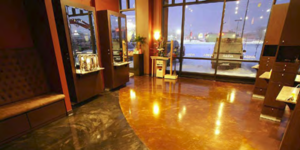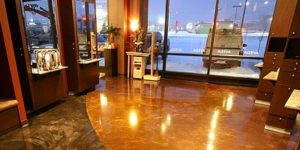It’s the middle of winter, and unless you live in the Deep South or Desert Southwest, the weather is not what you would call conducive to pouring concrete. This does not necessarily mean you have 3 feet of snow on the ground or subzero temperatures for days on end. In fact, the American Concrete Institute states that cold-weather concrete practices are to be used when the weather is below 40 F for three consecutive days — not exactly what I consider arctic conditions but cold enough to affect concrete when it is green and in its most delicate state.
There are many regions where the weather does not seem winterlike but is cold enough to affect concrete placement. This is where cold-weather placement practices become very important. Not following the rules because it does not seem that cold potentially leads to concrete that is weak and substandard.
Take it a step further and add color or a decorative finish, and the cold-weather placement practices may change yet again. Cold-weather practices are proven and have been around for some time, but they don’t always apply straight across the board when you are dealing with decorative concrete. As we all know, to achieve success, the decorative industry must stray from time to time from the tried-and-true placement procedures the gray concrete industry has used successfully for decades. Placement of decorative concrete in cold weather is one of those times. Let’s take a closer look at how cold weather affects and in some cases shuts down placement of colored decorative concrete.
Northern exposure
I actually know many installers in the colder northern climates who shut down their exterior concrete crews for the winter. To stay busy they turn to inside work, or for those lucky enough to have squirreled away enough cash during the summer, they take the winter off. The shut-it-down approach is actually sage advice in areas where temperatures drop below freezing before Thanksgiving and don’t go north of it again until April.
This brings me to an important point: Too often I have seen novice decorative installers try to squeeze out the last few jobs of the year and work well past the point when the seasoned pros have hung it up for the year. Unless your clients have enough money to pay for a tenting operation, the potential for a concrete failure and a callback are not worth forcing those last jobs of the year. If you work in a climate where it gets really cold, the safe bet says shut ‘er down — saving your company’s reputation and hard-earned cash.
In the middle states
Now that we have touched on our friends to the north, let’s look at all of those who live in what I call the “winter middle zone,” the large zone of real estate that runs the length of the country sandwiched between the warmth of the south and the cold to the north. These places get winter, but they also get enough mild (and I use that term loosely) days to warrant keeping outside concrete operations running year-round. These are places like Kansas City, Oklahoma City, St. Louis and Washington D.C., to name a few. Pouring gray concrete is a no-brainer — if the forecast is above freezing, pull out the blankets and call in the crew. With decorative concrete, it’s not quite that simple.
Integral color is susceptible to variation and blotchiness when the weather is perfect in early June, let alone at 37 F with a chance of freezing rain. One of the biggest factors in achieving colored concrete success is maintaining consistency from batch to batch, as well as consistent finishing and curing. When the temperature dips, the humidity usually goes up and curing slows down. All the extra moisture in the air and the slow cure time is a recipe for efflorescence, blotchiness and color variation. If accelerators are needed, think twice about pouring colored concrete, and if blankets are needed, I say cancel the pour. Once a curing blanket is laid on colored concrete, any chance for color uniformity goes out the window.
If you are stamping concrete, the same rules apply, with the exception of using release powder. The powder can act as a barrier between a blanket and the concrete, allowing stamped concrete projects to have a better chance for success in cold weather compared to integral color pours.
Stains (and dyes approved for exterior applications) are mostly water-based systems. As the temperature goes down, the humidity usually goes up, and concrete becomes more laden with moisture from the air. The more water concrete is carrying, the less it will be able to absorb of a stain or dye. Also, the evaporation rate of the stain carrier slows, and you end up with the stain never penetrating or reacting to achieve full color. Most stains recommend a minimum air and surface temperature of at least 50 F.
Most overlays are cement-based, and so you would think you should follow standard cold-weather practices with them. However, this is one of those cases where a decorative system deviates from standard practice.
Because overlays are so thin and have reduced cement content when compared to standard concrete, they do not generate as much heat as a 4-inch, 3,000-psi slab does. The lack of heat means that the 40 F temperature benchmark used as a cold-weather guide for when to place standard concrete is too cold for most overlay projects. Based on my experience, air and surface temperatures of 50 F are about as cold as you ever want to go with an overlay, and unless you want to wait a long time for the product to cure, I recommend 60 F as the minimum air and surface temperature for cold-weather overlay applications.
Sealing in the cold
Decorative sealers are pretty cut and dried. The universally accepted minimum air and surface temperature for sealer application is 50 F, unless you are using a special coating, such as a polyurea, which can handle application temperatures below freezing. If you must seal concrete in temperatures close to 50 F, wait until the middle of the day to allow the concrete to get as warm as possible. Another hint that may save a headache: Consider using a high-quality cure-and-seal if the concrete is below 60 F and the humidity is high. The chemistry of cure-and-seals allows them to handle moisture contact better than a straight sealer.
At the end of the day, the responsibility of making the decision to pour or not to pour in cold weather lies squarely with the installer. The pleading and pressure from a homeowner waving a check in your face, asking you to squeeze in that last project of the year, can be tempting. Unfortunately, that pleading is usually long-forgotten when the callback comes next spring.
